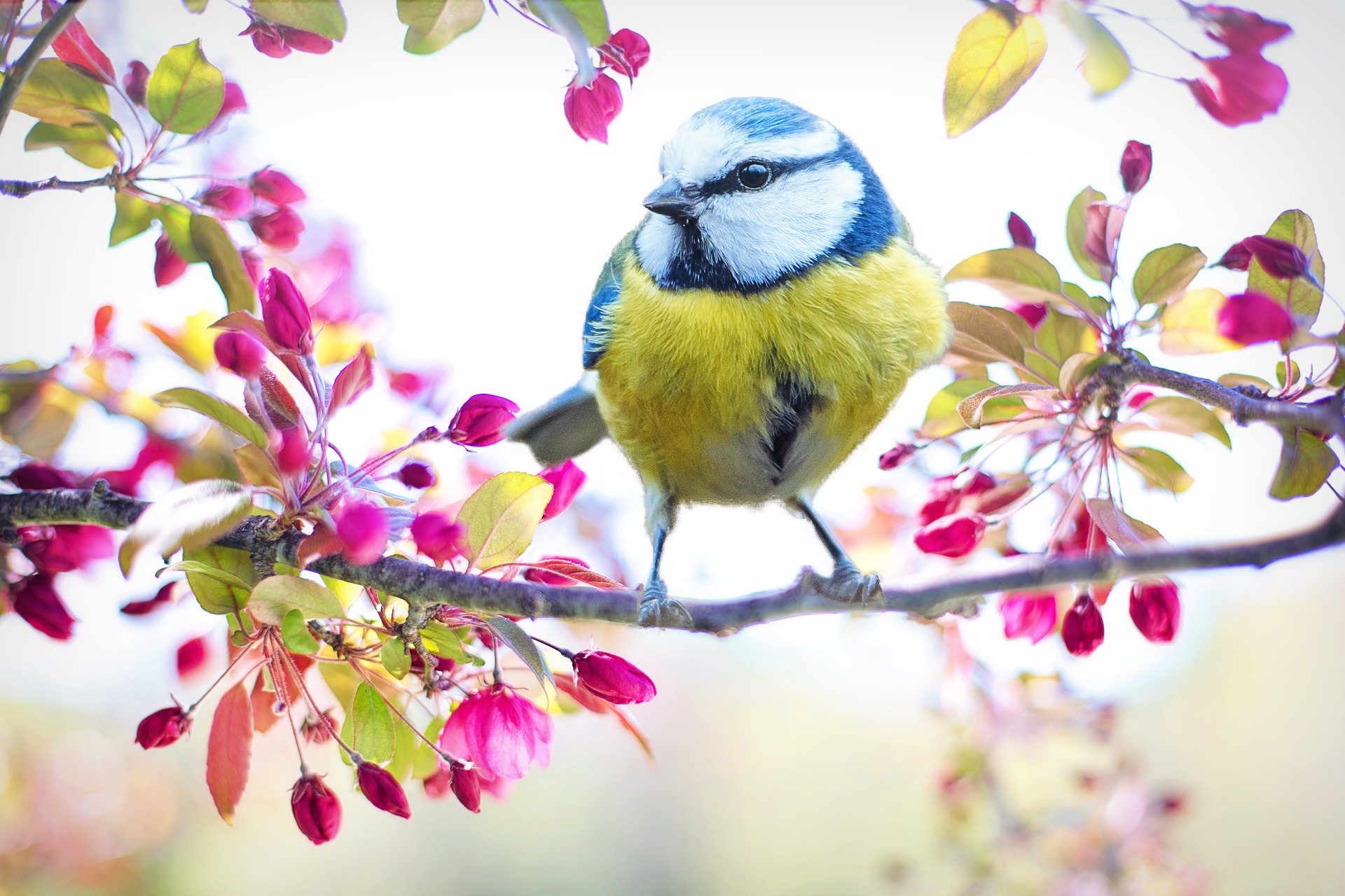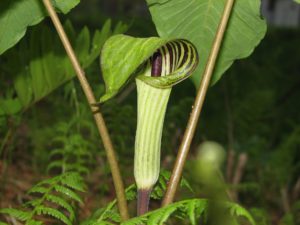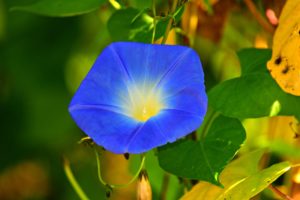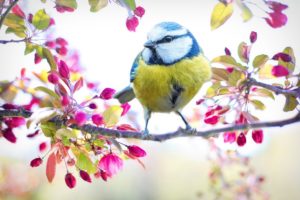
Spring is the best time of the year, the weather is getting a little warmer, the days are staying lighter longer, and the birds have returned. Okay, so there are some downsides – rain, pollen, and some dangers for our pets that you should be aware of.
Let’s start with gardening, everyone loves to start planting and cleaning up around the yard at the first signs of good weather. There are a couple of things to be aware of
- Cocoa mulch during the spring lots of people use mulch. Most of it is fine however, because cocoa mulch is made from cocoa beans it contains
 theobromine, this is the active ingredient in chocolate and it is the reason why we are concerned when a dog eats chocolate. Granted it does take a fair bit of mulch to harm a large dog, it does not take that much to harm a small dog. It is safest to avoid this type of mulch as there are other less harmful products to use that will look just as great around your trees and flower beds.
theobromine, this is the active ingredient in chocolate and it is the reason why we are concerned when a dog eats chocolate. Granted it does take a fair bit of mulch to harm a large dog, it does not take that much to harm a small dog. It is safest to avoid this type of mulch as there are other less harmful products to use that will look just as great around your trees and flower beds.
- Spring plants: many plants that we use can be toxic, think bulbs, most people are aware of lily toxicity, these are very dangerous for cats in particular. There are however other plants that are harmful. Here is a list from Toxic Plants in Small Animal Toxicology and Poisonings. St. Louis, MO: Mosby; 1998
Anemone Species
Common names: Pasque flower, windflower, lily of the field, wild crocus
Description: Small daisy-type flowers in a range of colors from pale blue to pink with yellow centers. A ruff of divided leaflets is found below the flower along the stem. Leaves vary in size depending on the cultivar but usually have three lobes and a toothed margin.
Toxins: Protoanemonin (an irritating oily substance)
Signs: Pain and swelling of the mouth, acute inflammation of the oropharynx accompanied by salivation, and/or pawing at the mouth and drooling may occur following ingestion. Edema of the lips, tongue, and throat may also be seen.
Caltha Species
Common names: Marsh marigold, cowslip, meadow bright, soldier’s buttons
Description: Yellow-gold flowers are found in large numbers on branching stems. Leaves are heart shaped to almost round with a diameter of 2–3 inches. This bog plant is found in sunny locations and around the margins of water gardens.
Toxins: Protoanemonin (an irritating oily substance)
Signs: The plant toxin is very irritating to the mucous membranes, and blisters are commonly seen after the plant is chewed. Because of this, ingestion is quite rare; if the plant is ingested, hemorrhagic gastroenteritis occurs.
Convallaria Species
Common names: Lily of the valley
Description: Dainty stalks arch over broad-pointed leaves that are 6–8 inches long and 3 inches wide. Flowers begin as small, ball-like buds and open to scalloped-edged, drooping flowers that release a distinctive, sweet fragrance.
Toxins: Cardiac glycosides, including convallatoxin
Signs: Anorexia, nausea, vomiting, ataxia, cardiac dysrhythmia, confusion, weakness that progresses to collapse, and death can occur following ingestion.
Dicentra Species
Common names: Bleeding heart, Dutchman’s breeches
Description: Pale pink to white flowers are borne on graceful drooping stems. Most flowers are heart shaped, but those of Dutchman’s breeches looks like pants hanging on a clothesline. The leaves are fernlike and grayish-green in color and extended along the entire length of the 1–1.5 foot stem.
Toxins: Protopine (an isoquinoline alkaloid)
Signs: Onset of signs is acute following plant ingestion. Trembling, hyperexcitability, salivation, and vomiting can be seen within minutes of ingestion. Signs can progress to recumbency and seizures; death rarely occurs.
Hyacinthus Species
Common names: Hyacinth, garden hyacinth
Description: Numerous drooping flowers are found on an erect stem. Colors range from shades of blue to pink and white. The strap-shaped leaves appear first and remain long after the flowers fade. Many cultivars have a distinct, sweet fragrance.
Toxins: Alkaloids
Signs: Signs may range from irritation of the mucous membranes to gastrointestinal distress, nausea, and vomiting.
Narcissus Species
Common names: Daffodil, jonquil
Description: The base of this trumpet-shaped flower is surrounded by flatter petals. The flower can be found in a wide variety of colors and sizes. Yellow tends to be the most common color, although white and pink are also seen. The long strap-shaped leaves persist long after the flowers have faded.
Toxins: Alkaloids, including narcissine, narcipoietin, and lycorine (an emetic)
Signs: Gastrointestinal distress, including vomiting, intestinal cramping, and diarrhea is typical. Rarely, tremors or convulsions are seen. Hypotension due to fluid shifts within the body and death may occur in severe cases.
Summer Blooming Plants
Aconitum Species
Common names: Monkshood, aconite, friar’s cap, friar’s cowl, wolfsbane, bear’s foot, helmet flower
Description: This perennial has deep purple-blue flowers and dark green, shiny, deeply cut leaves. It grows in full sun to partial shade and can reach a height of 2½–3 feet.
Toxic parts: All parts of the plant is toxic, including vase water in which the plant is placed.
Signs: The alkaloid aconitine disrupts the cardiac conduction system at low doses and inhibits it at higher doses; various dysrhythmias or even death can occur. Irritation of the mucous membranes, salivation, nausea, and vomiting are common after ingestion.

Arisaema Species
Common names: Green dragon, dragon arum, Jack-in-the-pulpit, wakerobin (This group of plants is a subspecies of Arum.)
Description: This moist woodland plant is grown for its small, hooded, tubular spathes that enclose spadices of minute flowers. The ovate to arrow-shaped leaves are densely arranged on long leaf stalks.
Toxic parts: Every part of the plant
Signs: Animals that have chewed on the plant may experience pain and swelling of the mouth. Acute swelling of the back of the oropharynx followed by salivation, pawing at the mouth, and drooling may also occur. Edema of the lips, tongue, and throat may be seen.
Baptisia Species
Common names: Wild indigo, false indigo, prairie indigo
Toxic parts: Every part of the plant
Signs: Nausea with possible vomiting is typical. The toxin involved can theoretically cause depressed breathing and respiratory arrest.
Digitalis Species
Common names: Foxglove, digitalis, fairy bells, fairy gloves
Description: Oblong to lance-shaped green leaves begin as rosettes at the base and alternate up the stalk. Flowers look like inflated tubular bells and are frequently spotted on the inside. Stalks are tall, often higher than 3 feet. Colors range from cream to dark pink.
Toxic parts: Every part of the plant is toxic, including the vase water in which the plant is placed.
Signs: Abdominal pain, nausea, vomiting, salivation, and local irritation of the mucous membranes are noted shortly after ingestion. Pulse may be slow and strong soon after ingestion, but can become rapid and weak if large amounts are eaten. Heart conduction abnormalities (e.g., premature ventricular contractions and ventricular tachycardia) are seen on ECG and may be severe enough to contribute to signs of ataxia, hypotension, shock, collapse, and death. Pupils may become dilated.
Hemerocallis Species
Common names: Day lily, road lily
Description: This clump forming plant has large strap-shaped dark-green leaves. Because of hybridization, flowers come in a vast variety of forms and colors. They are borne on erect, sometimes branching scapes. The flowers usually last for only 1 day, although multiple flowers are borne on each scape.
Toxic parts: Every part of the plant is toxic to cats; it is unknown whether this is also true for dogs.
Signs: In cats, ingestion results in nonspecific signs followed by acute kidney failure within 24–48 hours.
 I
IIpomoea Species
Common names: Morning glory, blue star, flying saucers, heavenly blue, pearly gates, wedding bells
Description: This twining, climbing vine, which can reach heights of 5–10 feet, has large sky-blue flowers with yellow throats. The leaves are slender and pointed.
Toxic parts: The seeds formed after flowering are the source of hallucinogenic compounds (LSD – lysergic acid diethylamide).
Signs: The seeds contain hallucinogenic compounds that can cause bizarre behavior in animals. The animals may appear confused with ataxia, restlessness, and disorientation. Nausea, vomiting, diarrhea, hypotension, and mydriasis may be seen.
Lilium Species
Common names: Varieties include Easter lily, Madonna lily, Asiatic lily, Oriental lily Turks-cap lily (the botanical family name is Lily)
Description: The bulb produces stems that can grow to heights for 5–8 feet. The lancelet leaves are dark green and commonly found scattered up the stem. Because of hybridization, there is a great variety of shapes and colors.
Toxic parts: The entire plant is toxic to cats, including the vase water in which the plant is placed; it is unknown whether this is also true for dogs.
Signs: In cats, ingestion results in nonspecific signs followed by acute kidney failure within 24–48 hours.
Lobelia Species
Common names: Cardinal flower, asthma flower, eyebright, Indian tobacco, lobelia
Description: This plant has brilliant scarlet to light blue flowers and lanceolate, toothed leaves; plants grow to heights of 1–3 feet.
Toxic parts: Every part of the plant
Signs: Lobelia has been used as an emetic, respiratory stimulant, and expectorant. Signs often include nausea, vomiting, weakness, mydriasis, hypothermia, salivation, diarrhea, anorexia, shock, and death.
Nicotiana Species
Common names: Tobacco, flowering tobacco
Description: The tubular trumpet-shaped flowers are available in a wide variety of colors. They are usually borne on panicle and may occasionally be scented. They have alternate linear or oblong-shaped to broadly ovate hairy leaves.
Toxic parts: Every part of the plant; contact with foliage can cause skin irritation.
Signs: The onset of signs is rapid after ingestion. Animals will become excited or hyperactive. Salivation, vomiting, and diarrhea are often seen; urination and lacrimation may also occur. With higher doses or prolonged exposure, animals may have tremors or muscle twitches, be unable to stand, and experience rapid shallow breathing (tachypnea) followed by slower breathing (bradypnea). Tachycardia, collapse, coma, and death may follow.
Ranunculus Species
Common names: Buttercup, crowfoot
Toxic parts: The entire mature plant is toxic; immature plants (i.e., those that have not yet bloomed) can be boiled and eaten as greens.
Signs: The plant toxin is very irritating to the mucous membranes; blisters are commonly seen after the plant is chewed. Because of this, ingestion is quite rare because of the severity of the mucous membrane irritation. If the plant is ingested, severe hemorrhagic gastroenteritis occurs.
- Heartworm Disease: Heartworm is carried and transmitted by mosquitos. Heartworm must go through one dog and be passed on to another via the mosquito. Remember it is any dog, fox, coyote or even wolf that can carry heartworm and the mosquito can transmit it to your dog. The mature worms live in the heart and lungs of dogs and cats. They can cause heart failure, fluid accumulation in the belly, and breathing problems. While heartworm infection can be treated, it can be uncomfortable, expensive and unnecessary with the new heartworm preventatives available.
- Ticks: We all know the dangers of ticks, they can carry all types of disease. Please ask us what is the best preventative for your pet, there are several options and the recommendations may vary depending upon lifestyle of the pet and the make up of the family.
- Exercise: So what could be bad about exercise? It helps control weight, improve mobility, and improved quality of life. Well, just like any athlete, if we ask a dog to do too much after the sedentary winter they can hurt joints, ligaments, and just become plain old sore the next day.
- Allergies: The beauty of living in the Hudson Valley can sometimes be eclipsed by all the pollen. Your pet suffers as well. Even if they never go outside they can still be exposed to allergies. This is the time of the year when we see the most ear and skin infections. Ask us if your pet suffers from allergies, we have several new medications to help control the signs.
We want everyone to have a healthy and happy spring, get out there and enjoy!!!
 [/vc_column_text][/vc_column][/vc_row]
[/vc_column_text][/vc_column][/vc_row]
